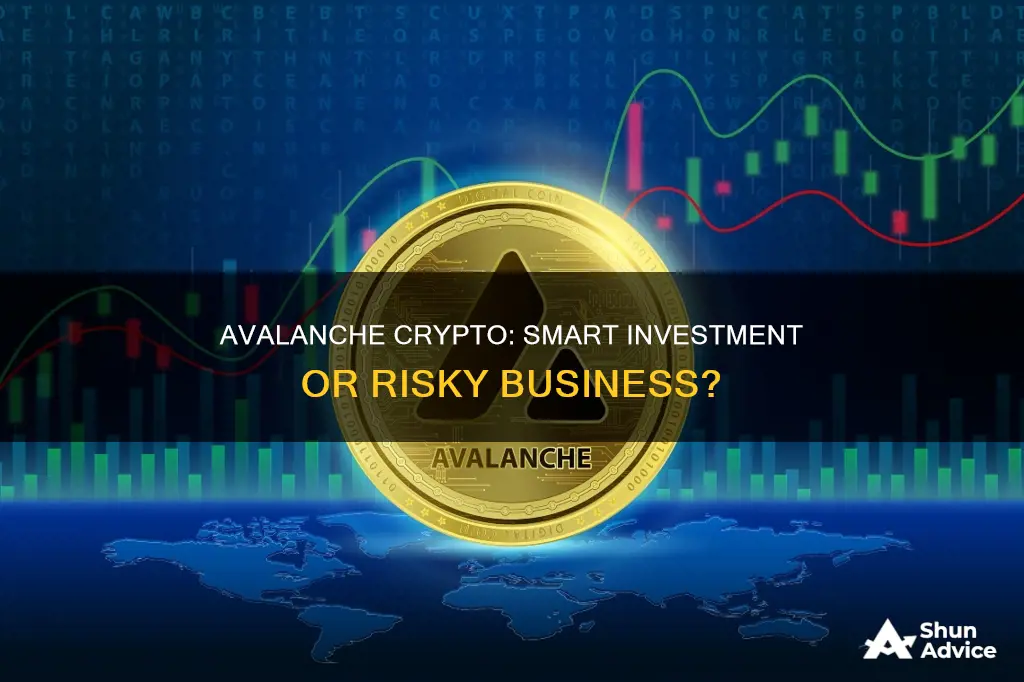
Avalanche (AVAX) is a smart-contract-based blockchain network that prioritises transaction speed, low pricing, and environmental friendliness. It is a proof-of-stake platform with a native token, AVAX, used for staking, paying transaction fees, and governance. Avalanche's triple-blockchain architecture and scalability have resulted in its increased adoption, with over 150 projects in its ecosystem, including decentralised finance (DeFi) wallets and non-fungible token (NFT) marketplaces. Its scalability is achieved through the use of subnets, which are dynamic sets of validators working together to achieve consensus on the state of a set of blockchains. The ability of the Avalanche network to handle a large volume of transactions per second (TPS) has positioned it as a capable adversary to the Ethereum network.
The price of AVAX has been volatile, with an all-time high of $146.22 in November 2021 and a low of $2.79 in December 2020. As of August 2024, AVAX is trading at around $22.67, with a market capitalisation of $8.95 billion, making it the 12th largest cryptocurrency. According to price predictions, AVAX could reach $50 by 2026 and $100 by 2028. By 2030, AVAX is expected to trade between $244.11 and $310.02, with an average price of $253.26.
While the high transaction throughput, low fees, and scalability of the Avalanche network make it an attractive investment option, it is important to remember that the cryptocurrency market is highly volatile, and there are risks associated with investing in AVAX.
What You'll Learn

Avalanche's scalability and transaction speed
Avalanche (AVAX) is a cryptocurrency and blockchain platform that rivals Ethereum. AVAX is the native token of the Avalanche blockchain, which uses smart contracts to support various blockchain projects. Launched in 2020, Avalanche aims to be fast, versatile, secure, affordable, and accessible.
Avalanche claims to be the fastest smart-contract platform in the blockchain industry as measured by "time-to-finality". Time-to-finality is the time a user has to wait to receive confirmation that a transaction made on the blockchain will not be changed or cancelled.
Avalanche aims to achieve high-transaction throughput and scalability via its native Snow protocol, which combines the properties of a classical consensus protocol and Nakamoto consensus.
Under the Avalanche Snow protocol, each computer, or node, on the network polls a small, constant-sized, randomly chosen set of neighbouring nodes to achieve consensus, instead of the "all-to-all communication" seen in classical consensus protocols. This allows Avalanche to process 4,500 transactions per second, compared to Ethereum's limit of 15.
The use of subnetworks, or subnets, on Avalanche helps to reduce network traffic and facilitate customisability on its network. Avalanche says a subnet is a dynamic set of validators working together to achieve consensus on the state of a set of blockchains.
> "High-speed financial applications are the norm for Web2, and for Web3 to compete and have parity with Web2, you do need a high-speed chain. Avalanche gets us closer and closer and possibly arriving at parity with the speed of Web2 systems."
However, it is important to note that Avalanche's scalability and transaction speed have also faced some criticism. For example, as of December 4, 2023, the Avalanche blockchain network averaged only 12.89 transactions per second, far below its claimed capacity of 4,500 transactions per second.
Overall, Avalanche appears to have strong scalability and transaction speed capabilities, but there may be some discrepancies between claimed and actual performance.
Canadian Silver Coins: Worthy Investment or Not?
You may want to see also

AVAX's capped supply and deflationary nature
AVAX, the native token of the Avalanche platform, has a capped supply of 720 million coins. This cap on the total supply of AVAX coins is designed to create scarcity and counteract inflationary pressures. The AVAX coin holders govern how fast new coins are minted and can control the rate of new coin creation by voting to adjust the amount of AVAX paid as a reward for adding new blocks to the Avalanche blockchain. This feature of AVAX makes it deflationary in nature.
The deflationary nature of AVAX is further reinforced by the burning of all transaction processing fees on the Avalanche platform. Burning refers to the process of removing the fees from circulation, thereby reducing the overall supply of AVAX coins in the market. This mechanism ensures that AVAX becomes scarcer over time, which can drive its price upward. The burning of transaction fees also makes the Avalanche platform more attractive to users as it incentivizes them to use the platform by offering lower fees.
The capped supply and deflationary nature of AVAX are similar to that of Bitcoin, which also has a limited supply of 21 million coins. The scarcity created by the capped supply sets both AVAX and Bitcoin apart from traditional fiat currencies, offering unique opportunities and challenges for investors. Understanding the deflationary nature of AVAX can help investors make more informed decisions about their investment strategies.
In summary, AVAX's capped supply and deflationary nature are designed to create scarcity, reduce inflationary pressures, and drive up the price of the token. The burning of transaction fees further reinforces the deflationary characteristics of AVAX, making it a potentially attractive investment opportunity for those seeking exposure to cryptocurrencies with these specific attributes.
The Bitcoin Investment Dilemma: Worth the Risk?
You may want to see also

Avalanche's blockchain architecture
Avalanche is a layer one blockchain that functions as a platform for decentralised applications and custom blockchain networks. It is one of Ethereum's rivals, aiming to unseat Ethereum as the most popular blockchain for smart contracts.
The Avalanche network consists of three individual blockchains: the X-Chain, C-Chain, and P-Chain. Each chain has a distinct purpose, which is radically different from the approach Bitcoin and Ethereum use, namely having all nodes validate all transactions. Avalanche blockchains even use different consensus mechanisms based on their use cases.
The X-Chain is used to create and trade digital assets. The C-Chain is used to create smart contracts, and the P-Chain helps with the creation of new subnets and keeps track of active ones, alongside coordinating validators.
The use of subnetworks, or subnets, on Avalanche helps to reduce network traffic and facilitate customisability on its network. A subnet is a dynamic set of validators working together to achieve consensus on the state of a set of blockchains. Validators, also referred to as 'stakers', can be members of multiple subnets. Each blockchain built on Avalanche is validated by one subnet, and each subnet can validate many blockchains.
Avalanche's subnet model reduces network traffic by allowing validators to choose which subnet to join in order to validate a blockchain. Subnets can also be designed to be private subnets by deciding which validators can enter them.
The Avalanche network has a default subnet which is validated by all validators. The default subnet, also known as the primary network, validates a set of three predefined blockchains on Avalanche: the X-Chain, C-Chain, and P-Chain.
Avalanche claims to be the fastest smart-contract platform in the blockchain industry "as measured by time-to-finality". According to Avalanche, time-to-finality is the time a user has to wait to receive confirmation that a transaction made on the blockchain will not be changed or cancelled.
Avalanche aims to achieve a high-transaction throughput and scalability via its native Snow protocol, which combines the properties of a classical consensus protocol and Nakamoto consensus.
The Avalanche consensus mechanism does not have one leader processing transactions that get validated by others. Instead, all nodes process and validate transactions by employing a directed acyclic graph (DAG) protocol. That way, transactions are processed simultaneously, and validators' random polling ensures that transactions are correct with statistical certainty. There are no blocks in this consensus mechanism, allowing immediate finalization and significantly improving the blockchain's speed.
Cryptocurrency Investment: Safe or Risky Business?
You may want to see also

AVAX's growth potential
Avalanche (AVAX) has been billed as the "world's fastest blockchain network". It aims to address the issues of increased transaction speed, decentralisation, and security. The Avalanche network is designed to act as a significant power booster, bringing radical transformation to finance. The Avalanche ecosystem is fully compatible with Ethereum assets, apps, and tools, offering faster speeds, higher throughput orders, and lower fees.
AVAX, the native token of the Avalanche platform, is used for staking, paying transaction fees, and voting on proposed changes to the network. It also functions as a rewards and payment system for users. The total supply of AVAX is capped at 720 million coins.
Avalanche claims to achieve high-transaction throughput and scalability through its native Snow protocol, which combines the properties of a classical consensus protocol and Nakamoto consensus. This allows the network to validate transactions faster than Ethereum.
The use of subnetworks, or subnets, on Avalanche helps to reduce network traffic and facilitate customisability. Each subnet is a dynamic set of validators working together to achieve consensus on the state of a set of blockchains. Avalanche has a "default subnet" that is validated by all validators and is used for creating and trading digital assets, creating new subnets, and creating smart contracts.
The current price of AVAX is around $23-24 as of September 2024, with a market capitalisation of around $9.5-9.8 billion, making it the 12th or 16th largest cryptocurrency by market cap. AVAX first entered the market in September 2020 at a price of about $5. It reached its all-time high of $146.22 on 21 November 2021.
Looking at price predictions, it is estimated that AVAX may trade between $19.43 and $58.31 in 2024, with an average price of around $35. In 2025, the price is expected to range between $34.80 and $60.55, with an average of around $60.
For 2030, predictions vary widely. Cryptopolitan predicts that AVAX will range between $244.11 and $310.02, with an average of $253.26. Meanwhile, DigitalCoinPrice predicts a minimum price of $185 and a maximum of $462.
In the long term, AVAX is expected to continue making significant gains, with Cryptopolitan predicting a price of $500 by 2030. By 2040, the maximum Avalanche value could potentially hit $2,500, and by 2050, the maximum price could be $5,000.
However, it is important to remember that price predictions can often be wrong, and the actual prices may be higher or lower than predicted. The cryptocurrency market is extremely volatile, and it is difficult to accurately predict a coin's price even in the short term.
A Beginner's Guide to Investing in Ravencoin
You may want to see also

Avalanche's competition with Ethereum
Avalanche (AVAX) is a blockchain platform and cryptocurrency that rivals Ethereum. Launched in 2020, it aims to be fast, versatile, secure, affordable, and accessible. It is an open-source project, meaning anyone can view and contribute to its code.
Avalanche's unique consensus mechanism, the Snow protocol, enables it to process transactions faster than Ethereum. It can handle up to 6,500 transactions per second, while Ethereum currently manages around 15 transactions per second. However, it is important to note that Ethereum's upgrades are expected to increase its transaction speed to over 100,000 per second, but these upgrades are likely years away.
Avalanche's architecture consists of three separate blockchains: the X-chain, C-chain, and P-chain, which ensure the network is fast and scalable. The C-chain, for instance, supports Ethereum-compatible DeFi applications, NFTs, and smart contracts.
In terms of fees, Avalanche is a more cost-effective option than Ethereum. The average transaction fee on Avalanche is estimated to be $0.08, while the average transaction fee on Ethereum is typically around $1.50.
When it comes to adoption, Ethereum is far ahead of Avalanche. Ethereum is one of the most popular and well-known cryptocurrencies globally, with many decentralized applications built on its network. As of September 2023, Ethereum supported more than 1 million transactions per day, while Avalanche supported over 150,000.
Avalanche's DeFi ecosystem is not as developed as Ethereum's, and it has not reached the same level of adoption. However, Avalanche's scalability advantages may make it a superior option for NFT games and other use cases that require high transaction throughput.
In summary, while Avalanche has technical advantages over Ethereum in terms of speed and fees, Ethereum currently has a much larger user base and is the most used smart contract blockchain. It will be challenging for any competitor, including Avalanche, to surpass Ethereum in the future due to its first-mover advantage and network effects.
Magic Coin: A Worthy Investment?
You may want to see also
Frequently asked questions
Avalanche is a leading Layer 1 network and a proof-of-stake smart-contract platform that seeks to rival Ethereum in smart contract functionality, scalability and transaction speed. The native token, AVAX, is used for governance, staking and validating network transactions.
According to Changelly, AVAX could trade at around $79.33 in 2025, while CoinPedia predicts it could reach as high as $100.
Changelly predicts AVAX to trade around $225.20 in 2030, representing an increase of over 8,900% from current prices.
AVAX has strong tokenomics and is well below all-time highs, leaving room for growth. It has a scalable and fast network, and its transaction fees are lower than Ethereum's.
Cryptocurrencies are highly volatile and AVAX has had uptime issues, being inaccessible at times since its inception. There is also a lot of uncertainty affecting the price of AVAX in the future.







